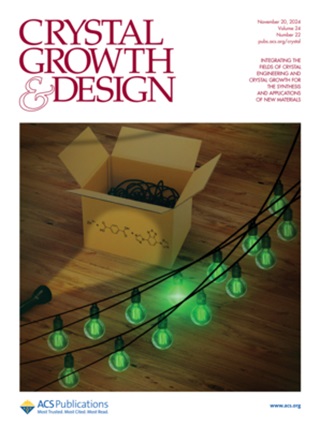二维交织金属-有机骨架结构跃迁促进质子电导率增强。
IF 3.2
2区 化学
Q2 CHEMISTRY, MULTIDISCIPLINARY
Crystal Growth & Design
Pub Date : 2024-12-24
eCollection Date: 2025-01-15
DOI:10.1021/acs.cgd.4c01279
引用次数: 0
摘要
我们报道了MFM-504(Cu)-DMF在暴露于MeOH和H2O蒸汽时分别通过配体取代向MFM-504(Cu)-MeOH和MFM-504(Cu)-OH的结构相变促进了质子电导率的提高。MFM-504(Cu)- dmf可由Cu(NO3)2·3H2O与柔性两性离子配体咪唑-1,3-双(亚甲基二羧酸盐)(imidc-)溶剂热反应合成,形成独特的层状交织网络结构。在80℃和99%相对湿度下,MFM-504(Cu)-OH的质子电导率为5.01 × 10-4 S cm-1,活化能(ea)为0.80 eV,表明MFM-504(Cu)-OH内部存在载体机制。本文章由计算机程序翻译,如有差异,请以英文原文为准。
Enhanced Proton Conductivity Promoted by Structural Transition in a 2D Interwoven Metal-Organic Framework.
We report enhanced proton conductivity promoted by a structural phase transition of MFM-504(Cu)-DMF to MFM-504(Cu)-MeOH and to MFM-504(Cu)-OH via ligand substitution upon exposure to MeOH and H2O vapors, respectively. MFM-504(Cu)-DMF can be synthesized by the solvothermal reaction of Cu(NO3)2·3H2O and the flexible zwitterionic ligand, imidazolium-1,3-bis(methylenedicarboxylate) (imidc-), to afford a unique layered interwoven network structure. MFM-504(Cu)-OH shows a proton conductivity of 5.01 × 10-4 S cm-1 at 80 °C and 99% relative humidity (RH) with an activation energy (E a) of 0.80 eV, indicating a vehicle mechanism within MFM-504(Cu)-OH.
求助全文
通过发布文献求助,成功后即可免费获取论文全文。
去求助
来源期刊

Crystal Growth & Design
化学-材料科学:综合
CiteScore
6.30
自引率
10.50%
发文量
650
审稿时长
1.9 months
期刊介绍:
The aim of Crystal Growth & Design is to stimulate crossfertilization of knowledge among scientists and engineers working in the fields of crystal growth, crystal engineering, and the industrial application of crystalline materials.
Crystal Growth & Design publishes theoretical and experimental studies of the physical, chemical, and biological phenomena and processes related to the design, growth, and application of crystalline materials. Synergistic approaches originating from different disciplines and technologies and integrating the fields of crystal growth, crystal engineering, intermolecular interactions, and industrial application are encouraged.
 求助内容:
求助内容: 应助结果提醒方式:
应助结果提醒方式:


